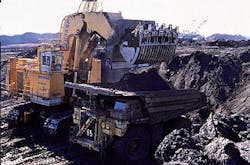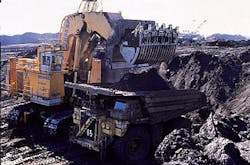Canadian oil sands research keeps production competitive, prospects for growth bright
The future of Canada's continuing capacity to produce and export oil lies in the massive oil sands deposits in the Fort McMurray region of northern Alberta. Reserves recoverable with current technology are estimated at more than 300 billion bbl of bitumen.
Canada's oil sands resource is expected to play a key role in any North American continental energy plan. Whether oil sands production meets its potential will depend heavily on the ability of a substantial, and often cooperative, research effort by industry, government agencies, and universities to find more-efficient and more-economic ways to recover, transport, and process the oil sands.
Research has helped make oil sands and heavy oil recovery production costs competitive with conventional crude and other energy commodities. The consistent trend since the late 1970s, with some blips in the graph, has been a steady reduction in production costs, largely attributed to research efforts.
Expansions, new opportunities
Operators such as Syncrude Canada Ltd. and Suncor Inc. that operate existing oil sands projects already have a number of major expansion projects under way. These, plus projects under development or on the drawing board, are worth an estimated $51 billion (Can.). Current oil sands production of about 600,000 b/d is expected to grow to 1.9 million b/d within a decade.
Syncrude, Canada's largest oil producer, with production averaging 210,000 b/d, recently began planning a $4.1 billion third phase that will expand production by 110,000 b/d by 2005.
Meantime, Shell Canada Ltd. and partners in late summer announced plans to evaluate long-term development opportunities on their oil sands resources in the Athabasca area (OGJ, Aug. 20, 2001, Newsletter, p. 9).
The schemes include optimization and expansion of the Muskeg River Mine project on the western portion of Lease 13 and on Lease 90. The companies are considering bringing pro- duction capacity to 225,000 b/d from the current design of 155,000 b/d. If approved, work on the project would likely take place during 2005-10. The Muskeg River Mine is on track to come on stream in late 2002.
The group also is considering a stand-alone oil sands mine and extraction facility in the eastern portion of Lease 13. Jackpine Mine Phase One would have capacity of 200,000 b/d of bitumen. The project likely would follow the Muskeg River Mine expansion.
A third project would be a Jackpine Mine expansion, dubbed Phase Two. It would involve resources on Leases 88 and 89 and would add 100,000 b/d.
Research
Syncrude spends more than $30 million/year on research and has a state-of-the-art research center in Edmonton with a staff of 90 people.
Areas of research include analytical chemistry, bitumen chemistry, materials research, measurement and analysis, separation processes, slurry transport, and tailings management.
John Oxenford, Syncrude's manager of research programs, says one of the characteristics of Syncrude has been its ability to continually find ways to develop and implement technology.
"This has been one of the major contributors to our ability, and the oil sands industry in general, to contain and reduce costs year over year," Oxenford said.
"Many of the developments that have come from Syncrude's research have become standards for the industry."
Oxenford said that two of the main thrusts of Syncrude research include materials handling and environmental issues.
He said that conveyors originally transported oil sands excavated from the mine face to a bitumen extraction facility. Development of larger equipment-pumps, crushers, and trucks- and a slurrying device called a cyclo- feeder makes it possible to move oil sands by pipeline, with a significant cost saving. By 2003, pipelines or hydrotransport will move virtually all oil sands.
Environmental research is focused on reducing the energy intensity of processing, on reduced emissions and land disturbance, improved tailings disposal techniques, reduced bitumen losses, and improved reclamation. Environmental research becomes increasingly important as activity increases and standards are raised. Oxenford said a significant part of this work is being accomplished through a University of Alberta program, and intellectual property so developed is placed in the public domain.
Syncrude also is actively involved in research programs with outside partners, including the Alberta Research Council, universities, the National Research Council, and suppliers. Topics include materials research, development of catalysts, reducing energy consumption, bitumen conversion yield, and condition and risk-based maintenance.
A large volume of oil sands research that Syncrude, Suncor, and others conduct is shared through the Canadian Oil Sands Network for Research and Development. CONRAD coordinates collaborative research among 15 industry members, 5 government institutions, 2 universities, and an industry association. It holds regular workshops to share research results.
Oxenford noted that Syncrude spends more than $350 million/year on maintenance. Studies suggest these costs can be reduced by up to 25% by moving from time-based maintenance practices to condition-based systems. He said 99.9% of data from operating equipment will usually show that conditions are normal. The challenge is to find the 0.1% that indicates a fault before it develops into a catastrophic failure.
Syncrude also is researching intelligent systems and process control, which will detect problems such as lost teeth from a shovel bucket. Some of this work will be done at the Centre for Intelligent Mining Systems to be opened this year at the University of Alberta's Computer Science Department.
Cost reductions
Syncrude, a six-company consor- tium, says there has been a steady decline in its production costs, to $12.64/bbl in 1999 from $25.81/bbl in 1979. However, Syncrude experienced an increase in costs to $17.45/ bbl in 2000 and $21.02/bbl in the second quarter of this year. The group attributes the increase to maintenance costs, lower production, and high natural gas prices. The massive overhead costs of running an oil sands operation remain the same, even when production drops.
Mike Singleton, director of technology planning and integration for Suncor, Canada's second-largest oil sands producer, says production costs that were above $30/bbl in the late 1970s are expected to drop below $10/bbl in the next 2 years. Suncor has estimated that its leases contain reserves of more than 8 billion bbl.
"We believe that research and technology are key levers for the future to reduce our costs and improve environmental performance," Singleton said.
Singleton said that fine-tuning changes to the bitumen upgrading process has contributed significantly to cost reductions and that he expects many more improvements.
He said industry's switch from draglines to truck-and-shovel mining operations has cut costs significantly, and equipment suppliers have done important research in this area.
Suncor research includes a planned pilot project this year on solvents and steam-assisted gravity drainage work at its Firebag lease.
Singleton said that the company is investigating some proprietary upgrading technologies, but much of the industry research is shared.
"We're pulling together. I'm not aware of another industry that pulls in mining technologies, bitumen extraction, and upgrading technology and puts them all together," Singleton said, "That's the trick. There is cooperation between commercial operators such as Syncrude and Suncor, either through joint venture research or sponsored research at universities or CONRAD, formed to bring together these kinds of efforts."
New technology
In late summer, PanCanadian Petroleum Ltd., Calgary, and privately held Value Creation Inc., Calgary and Hong Kong, agreed to jointly develop upgrading technology for oil sands reserves.
Value Creation is developing a partial upgrading process that, PanCanadian said, has been tested with encouraging results at a small pilot plant. It would reduce costs, produce higher value grades of crude oil, and reduce or eliminate the need for diluent in transportation.
PanCanadian's Christina Lake development project could benefit from the technology, said the company.
Beginning in late 2002, PanCanadian will ship up to 10,000 b/d of blended bitumen from the first phase of its Christina Lake thermal project 170 km south of Fort McMurray, Alta., to En- bridge's Kirby Lake pipeline terminal and then through Enbridge's Athabasca Pipeline, connecting with the Enbridge mainline at Hardisty, Alta. (OGJ Online, June 22, 2001). PanCanadian said it hopes to be in a position to consider a commercial-scale plant as early as 2002.

